Banning Fur is Not an Issue of Race

(photo: @theanimalvoters)
The world around us is changing. People are making more ethical choices concerning the environment and the welfare of other species. We’re starting to use less plastic because of the impact it has on our oceans and ocean life. More and more people are choosing vegan milks and meats as they come to understand the ill effects that factory farming has on the planet.
A ban on fur in New York City would be a step in the same ethical direction.
New York has long been considered a fashion Mecca. We have always set the pace for others to follow, but on the issue of fur, we’re falling behind while everyone else is moving ahead.
Fur farms all over the world are already closing. Cities like Los Angeles, San Francisco, and West Hollywood have already banned sales of new fur items. Famous designers including Prada, Versace, Michael Kors, Armani, Gucci, and so many others are saying “no” to fur. New York is behind the curve. In 2019, wearing the skin of other sentient beings is simply unacceptable.
Two years ago, my daughter asked me for a Canada Goose coat. I told her, “Taj, you know I’d do anything for you, but you’re not getting that coat. You have a choice. Animals don’t.” I explained to her how coyotes are caught in steel traps and left in pain, struggling and crying, until a trapper finally arrives to shoot them or beat them to death—just so their fur can be used for the trim on a jacket hood. After I explained this to her, she didn’t want the coat anymore, and she asked me, “Daddy, why don’t they just use fake fur?”
That’s a question I want everyone reading this to think about. Why are we not using faux fur, especially when sustainable, vegan materials, such as faux fur made from hemp or recycled plastic bottles, are kinder to animals and the environment? Why are we putting profit over ethics?
Animals are not “things” to be used for our own ends any more than people of color are “things” to be used by whites.
I say this as a descendant of African slaves, who were brought to this country and used as a commodity. It disturbs me greatly to see other fellow sentient beings have their freedom and lives taken from them and be used as commodities for human gain.
Why would a people with a history of violated human rights approve of the unfair treatment of others? We should be speaking up for the most vulnerable among us.
To those in the African-American community who say that a fur ban is “racist” and a form of discrimination, please remember that you are not the victim. The victims are the millions of animals killed every year for what is rightfully theirs—their very skin and fur.
And to those in the African-American community who believe that a fur ban is an attack on our culture, you’re disregarding our own history of oppression. If you speak of freedom, but it’s only in regard to others who happen to look like you, is it really freedom? Shouldn’t we want freedom for all sentient life?
Banning fur is not an issue of race. It is an issue of rights. As humans, our morals can be judged by how we treat those who are the most vulnerable. That’s why I encourage everyone in the city to stand on the right side of justice and support the proposed fur ban. Oppression is oppression regardless of who it is happening to, and when we have the opportunity to end one form of injustice, we must seize it.
***
Stewart Mitchell is a leader in the animal rights movement in Brooklyn, author, and father.
***
Have an op-ed idea or submission for Gotham Gazette? Email This email address is being protected from spambots. You need JavaScript enabled to view it.
Lives on the Line: Legislature Must Reform Solitary Confinement Before Session's End
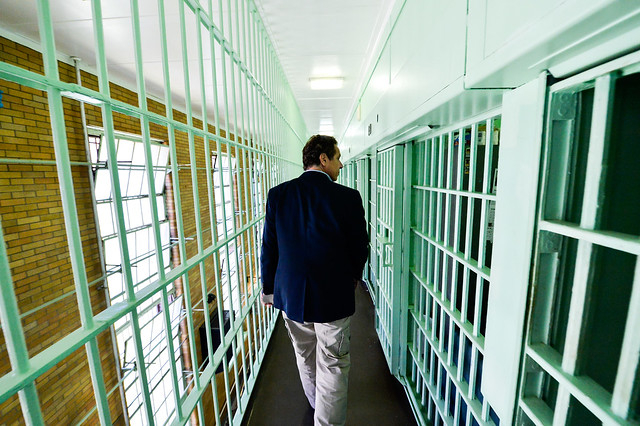
(photo: Governor's Office)
Thousands of people are subjected to long-term solitary confinement in New York. The United Nations calls it torture. New York’s jails and prisons call it business as usual.
Our state’s laws permit 23-hour confinement for months and even years at a time in jails and prisons across the state. This despite the fact that long-term solitary confinement creates severe and irreparable mental and physical trauma. Its effects can be deadly. The death this month of Layleen Polanco in a solitary cell at Rikers is just the latest example.
In 2015, the state and the New York Civil Liberties Union reached a settlement that required critical changes to the use of solitary confinement in state prisons. Although the state has made important efforts to reform solitary confinement for people in prisons, we need the legislature to pass more comprehensive changes to ensure that individuals held in both prisons and jails are no longer subjected to solitary confinement in state prisons and local jails that lasts longer than 15 consecutive days.
People in solitary confinement are seven times more likely to hurt or kill themselves. We cannot afford to wait on reform. Thousands of people are in danger and there is a bill in the state legislature that could help them.
The Humane Alternatives to Long-Term Solitary Confinement (HALT) Act would make several important changes to the way our state currently uses solitary. First, it would prohibit long-term solitary confinement by limiting the time spent in confinement to no more than 15 consecutive days or 20 days total in any 60-day period.
The HALT Act would ban the solitary confinement of especially vulnerable people, including those 21 years or younger, 55 years or older, and people with certain disabilities. The government would also be barred from locking up in solitary anyone who is pregnant or in post-partum recovery or anyone who is a new mother or caring for a child while incarcerated.
Critically, the legislation would prohibit solitary for all but a small set of serious offenses. And HALT would provide rehabilitative programming that would help keep jails and prisons safer for everyone, including staff. To that end, it mandates that all people in solitary receive at least six hours of out-of-cell rehabilitative programming, plus one hour of out-of-cell recreation per day.
In settling the NYCLU’s lawsuit, Governor Cuomo has acknowledged that the state needs to reduce its reliance on solitary confinement. The settlement was critical to reducing the state’s reliance on isolated confinement. But we need his leadership to push for more comprehensive reform that protects the health of everyone in our jails and prisons by ending prolonged solitary confinement.
No one should be subject to torture.
Speaker Carl Heastie and Majority Leader Andrea Stewart-Cousins must act now and bring HALT to a vote. In 2018, New Yorkers voted to end the gridlock in Albany that kept progressive legislation like HALT from passing. By voting for this bill, lawmakers will help show that this legislative session is different and that the status quo of Albany inaction is over.
***
Donna Lieberman is the Executive Director of the New York Civil Liberties Union. On Twitter @JustAskDonna & @NYCLU.
***
Have an op-ed idea or submission for Gotham Gazette? Email This email address is being protected from spambots. You need JavaScript enabled to view it.
Our Judicial Elections are Broken, But They’re No Joke
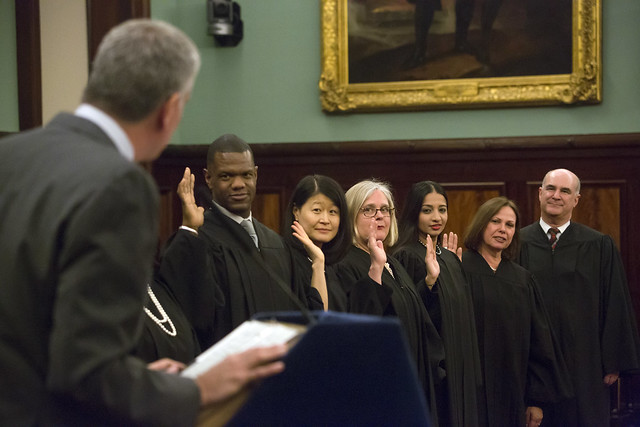
(photo: Ed Reed/Mayoral Photography Office)
On June 25, Brooklyn Democrats will hold a primary to select the Democratic candidates for judges of the Civil Court and judge of the Surrogate Court.
New York has a convoluted system for selecting judges. Some are appointed by the Governor. Criminal and Family Court judges in New York City are appointed by the Mayor. Candidates for Supreme Court are nominated at a judicial nominating convention, while candidates for Civil Court and Surrogate Court are elected through a traditional primary election.
Further complicating matters, candidates for Surrogate Court run county-wide as do some candidates for Civil Court. However, some candidates for Civil Court are elected by a subset of voters in what is called a “municipal district.”
This is a dysfunctional system. There is no justification for some judges to be appointed and some elected. There is no justification for some candidates to be nominated at a judicial convention and others to run in a primary. There is no justification for some judges to run county-wide and others to get elected by a subset of voters.
This convoluted system undermines the goal of a merit-based selection of judges, is almost entirely dominated by Democratic Party leaders, and lacks controls to prevent an unqualified candidate from becoming a judge.
Take, for example, this year’s primary for judge of the Surrogate Court. Judge Margarita Lopez Torres is running for reelection. She is an excellent judge who famously refused to give a patronage job at the direction of the then-Brooklyn Democratic Party boss, Clarence Norman, who would go on to serve a prison sentence for corruption.
As a result of her “defiance,” party leaders, who controlled the judicial nominating convention, blocked her from seeking election to the New York Supreme Court. She became the plaintiff in a lawsuit claiming the way New York elects Supreme Court judges was unconstitutional, which would eventually lose at the U.S. Supreme Court.
Her 14-year term now up, she faces a bitter primary from two opponents in her bid for reelection. Meredith Jones, while found qualified to be a judge of the Surrogate Court, is running at the behest of allies of the disgraced party boss whom Judge Lopez Torres spurned close to two decades ago and who are using the primary to seek retribution. The other primary opponent, Judge Elena Baron, is a sitting Civil Court judge elected only two years ago. After declining to appear before the New York City Bar Association for what she said are ethical concerns with the panel because the attorneys appear before judges that they rate, she was deemed "not approved." Her campaign is being run by a notorious political consultant who uses judicial elections as an opportunity to make money while “sticking it to the machine.” (I have endorsed Judge Lopez Torres in my capacity as an elected District Leader for Brooklyn's 44th Assembly District.*)
There are only two Surrogate Court judges in Brooklyn. They will decide thousands of sensitive cases dealing with complicated end-of-life issues. If Judge Baron were elected, 50% of cases would be heard a judge who should not be presiding over them. This does not “stick it to the machine.” It sticks it to the grieving Brooklynites going through the Surrogate Court to carry out the last wishes of their departed loved ones.
Likewise, the primary for Civil Court judge from the 6th Municipal District (where I live) features a candidate, Tehilah Berman, found not approved by both the Brooklyn Democratic Party screening panel and the New York City Bar Association.
Our legal system depends upon public confidence in the quality and integrity of the judges hearing our cases. Judge Berman's election to the Civil Court would be a mistake given her lack of relevant experience, including next to no litigation experience. When I recently confronted her about her lack of qualifications, her campaign manager sent me a message on Facebook threatening, “next time you will deal with me or one of my team members.”
It is time for New York to abolish judicial elections altogether in favor of a unitary merit-based appointive system. While appointment of judges is not without the potential for political influence, it would exponentially reduce the vice grip that the Democratic Party machine has on election of judges to the Supreme Court and significantly reduce the likelihood of an unqualified candidate becoming a judge of any court.
Likewise, there are highly-qualified attorneys who don’t seek judgeships because they refuse to play in the swamp of the current system, but would absolutely seek appointment in a merit-based system.
Finally, mechanisms can be implemented to reduce the influence of politics in the selection of judges. For example, under the current mayor, there is an open application process and the office responsible for political appointments plays no role in the evaluation and recommendation of applicants.
That said, the primary election is next week away and we have to vote in the system we currently have.
So, I ask all Brooklynites, before you vote, please do your research. Information about judicial candidates is often scant. But this year, many of the judges have Facebook pages and campaign websites. Visit them. New Kings Democrats have put out an excellent, much welcome and needed judicial election guide. Read it.
When unqualified judges get elected, two people win -- the unqualified judge and their campaign consultant. Hundreds of thousands of Brooklynites lose. These are real people, with real legal problems, who deserve to have their cases decided by real judges.
***
Doug Schneider is the Democratic District Leader for the 44th Assembly District covering parts of Park Slope, Windsor Terrace, Kensington, Boro Park, Midwood, and Ditmas. *He has endorsed candidates in three judicial races, two mentioned above (Judge Lopez Torres and Caroline Cohen for Civil Court from the 6th Judicial District, as well as D. Bernadette Neckles for Civil Court countywide). Although unofficial, for Supreme Court he has one of 42 votes in nominating Democratic candidates, a power he is advocating to end. On Twitter @DougSchneiderBK.
***
Have an op-ed idea or submission for Gotham Gazette? Email This email address is being protected from spambots. You need JavaScript enabled to view it.
Note: this article has been corrected to remove characterization of Baron's recommendation from the NYC Bar Association as "unqualified." The recommendation was "not approved."
Smells Like Teen Surveillance
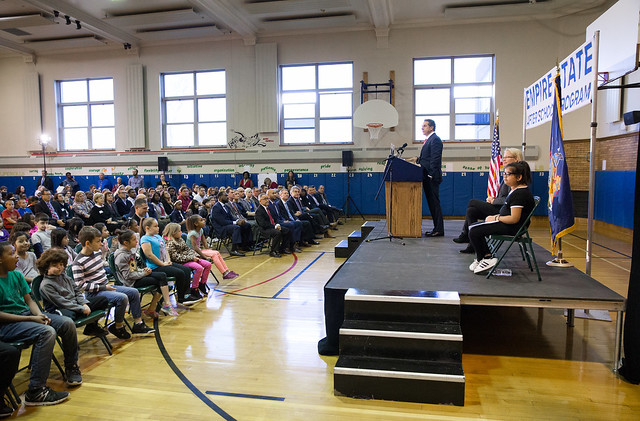
(photo: Philip Kamrass/Office of Governor Andrew M. Cuomo)
Picture a student sprinting to math class, late for a test after sleeping through the alarm. Hair disheveled, backpack open, their heart is racing. But in an instant this quintessential scene morphs into something far more dangerous as the student is faced with armed police officers, aiming their guns, demanding the student lie down on the ground.
This is the grim prospect for the students of Lockport, New York, whose school district is the latest to stumble headlong into the national surveillance debate.
In Lockport, students will no longer just be graded on their homework and exams, they’ll receive a grade from the school’s state-of-the-art surveillance boondoggle: facial recognition. Let’s be clear, facial recognition technology has no place in schools. It is expensive, invasive, and more than a little bit creepy. The newest versions claim they predict behavior, but that “suspected school shooter” is actually just an anxious kid who’s running late for a test.
Even worse, many facial recognition systems will label students as a “threat” because of their race.
The facts are clear: facial recognition is biased. The technology can be eerily accurate, but error rates are much higher for women and people of color. When one commercial product looked at members of Congress, it largely gave white representatives a pass, but falsely claimed that half a dozen of members of the Congressional Black Caucus were criminals.
Bias would be reason enough to scrap this Orwellian misadventure, but things get worse. Facial recognition fails more often for minors and people under stress. That’s right, they’re putting a racist surveillance technology that’s undermined by moody teenagers…in a high school.
And the problems don’t end there. Not only is facial recognition biased and broken, it is expensive. Lockport doled out nearly $4 million for their eight-school system. Millions that could support students, being used to surveil them instead. But the cost is more than dollars and cents; this system comes at a steep cost to student privacy. The system captures the biometric data of every person setting foot in the school, building a database that could be harnessed by law enforcement or even ICE.
Alarmingly, Lockport’s impact could extend far beyond the eight-square-mile town. Cities and states look to each other for policy innovation, copying each other on things related to “security” all the time. So long as state and federal officials allow money to be squandered this way, there will be a financial incentive for other school districts to follow Lockport’s dubious lead.
State officials must do more. In recent days, Governor Cuomo belatedly noted his “concerns” about this discriminatory surveillance net, but his comments are too little, too late. The half-hearted condemnation is particularly unconvincing in light of his past facial recognition advocacy.
Just last year, the governor rushed the roll-out of a disastrous facial recognition project on the Robert F. Kennedy Bridge that failed to detect a single face. It’s time for the governor to face the music on surveillance and call for a state-wide moratorium on facial recognition.
As a first step, we must prohibit facial recognition in schools -- it’s the very least we can do. That’s exactly what lawmakers might do in a few days when they should vote on a measure from Assemblymember Monica Wallace and State Senator Brian Kavanagh, banning biometric data collection in schools. The measure might be too late to help the students whose data was already recorded in Lockport, but we can make sure no other students have to give up their privacy and civil rights as the price of attending classes.
***
Cahn is the executive director of The Surveillance Technology Oversight Project, a New York-based civil rights and police accountability organization. On Twitter @cahnlawny. Blum is a rising 3L at NYU School of Law and a civil rights intern at The Surveillance Technology Oversight Project. On Twitter @JamesLBlum.
***
Have an op-ed idea or submission for Gotham Gazette? Email This email address is being protected from spambots. You need JavaScript enabled to view it.
Seize the Albany Opportunity to Do More for NYCHA
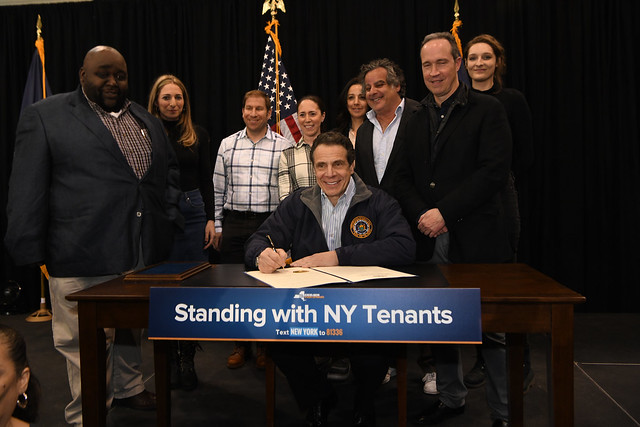
Danny Barber, left, is the author; with Gov. Cuomo & others (photo: the Governor's office)
I stood with Governor Cuomo last year when he showed how bad conditions in public housing have gotten after decades of federal neglect. With the governor’s leadership, NYCHA was allocated $250 million in last year’s state budget. While that money was held up due to the appointment of a federal monitor, the need for additional funds remains again this year.
Major capital repairs are needed to keep residents safe and healthy in all five boroughs. Leaks, mold, pests, broken elevators, and lead are a constant worry for us 400,0000 public housing residents as we try to get to work or school or care for our families at home.
The Assembly called for $300 million and the Senate asked for $250 million in the annual state budget process earlier this year. So far, NYCHA has gotten zero. This surprises me given the governor’s commitment and the tumultuous year NYCHA has had, leaving residents with great uncertainty about the future status of our homes.
State lawmakers have a chance to redeem themselves and commit to fighting to preserve NYCHA by appropriating capital funds before the end of this year’s legislative session, which is scheduled to finish this week and is expected to include decisions on capital allocations.
Albany also has an opportunity to create a more just and equitable tax policy while funding public housing, and it won’t cost a dime in state budget money.
This year, New York City will give away about $600 million to homeowners through the Cooperative and Condominium Property Tax Abatement, which reduces real property taxes for owner-occupiers by 17.5% to 28.1%, depending on assessed value. With the abatement scheduled to sunset this week, Albany lawmakers have an opportunity to provide a long-term funding solution for public housing.
Reform legislation has been introduced in the Assembly by Robert Rodriguez with a companion bill in the Senate sponsored by the housing committee chair Senator Brian Kavanagh. This bill preserves the tax abatement for 90% of homeowners, while eliminating tax breaks for the top 10% of luxury coops and condos.
By ending this tax break for the top 10% of luxury owners now, $170 million in tax revenue will be collected each year. The reform legislation earmarks this revenue for capital repairs in public housing, which can help bring NYCHA into compliance with federal regulations protecting tenants from health hazards such as mold, lead, and vermin.
More than 320,000 cooperative and condominium homeowners received an average tax break of $1,890 in fiscal year 2019 but benefits to luxury homeowners far exceed this average. President Trump, for example, was eligible for $48,000 in tax relief when he resided in Trump Tower. This reform bill will end tax breaks for luxury owners who don’t need them. New York City’s Housing and Vacancy Survey indicates that 10% of all coop and condo owners citywide earn more than $350,000 per year. That number contrasts sharply with $24,000, the average income for residents in public housing.
Albany lawmakers will have to decide if they want to renew the current abatement and perpetuate housing inequality or if they want to reform it by ending tax breaks to luxury properties and fund repairs that will benefit many thousands of public housing residents. The choice seems simple.
***
Danny Barber is Chair of the Citywide Council of Presidents of NYCHA residents, representing 400,000 public housing residents. He is also President of Jackson Houses Resident Inc., Chairman of the South Bronx District Council of Presidents Inc., and a member of Community Board 1.
***
Have an op-ed idea or submission for Gotham Gazette? Email This email address is being protected from spambots. You need JavaScript enabled to view it.
For the Earth's Sake, Enforce Bus Lanes with Cameras
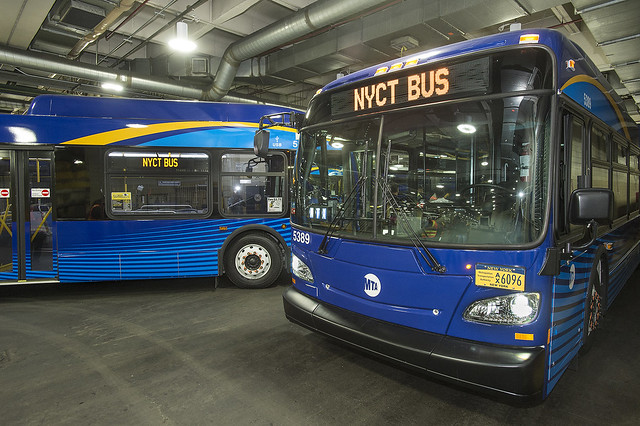
(photo: MTA/Patrick Cashin)
Transit policy is climate policy. In New York, transportation emits 30% of the city’s carbon pollution and 34% of the state’s. Since it’s easier to drive less in a city than in suburban and rural areas, much of that is carbon we can easily spare. When shrinking New York’s carbon footprint, transportation emissions are low-hanging fruit.
Granted, the challenge is stiff. Car registrations in the city are rising, up 9% in the past four years. The city’s own government vehicle fleet has grown 19% in size and 25% in miles traveled in the past five years. City agencies hand out an estimated 150,000 placards that privilege public employees to park their personal cars on our streets, encouraging them to drive rather than ride transit.
Car culture is resilient throughout the city. In many communities, a car is a status symbol. Many immigrants, low-income New Yorkers, and New Yorkers of color drive for a living. Taxi drivers protested the recent enactment of congestion pricing. Even progressives in Greenwich Village and Chelsea objected to shuttle bus service for L train riders displaced by construction.
To their credit, our leaders have made major commitments to transit. Governor Cuomo and the Legislature passed congestion pricing to fund major subway upgrades. Both Mayor de Blasio and the MTA made historic promises and have begun to improve bus service. City Council Speaker Corey Johnson successfully championed reduced transit fares for low-income riders in the city budget and made a public pledge to “break the car culture.” Comptroller Scott Stringer has produced game-changing reports on bus service and commuter rail.
But there’s a lot more to do. Shifting decisively away from cars and toward transit will require major policy change. If done right, it will make the city more equitable, enhance the quality of life for millions of New Yorkers, and help save everyone on the planet from out-of-control climate change.
First, it’s crucial that the governor fully implement congestion pricing. Congestion pricing has the potential to directly cut citywide carbon emissions by nearly one million tons annually. By cutting congestion, congestion pricing will also indirectly cut emissions even further by making it easier for families and businesses to locate or stay in the city rather than leave for more carbon-intensive lifestyles in the suburbs or beyond.
Second, congestion pricing revenue must be dedicated to fixing the subway. Despite recent improvements in performance, our subway system remains in crisis. While jobs, population, and tourism numbers hit record highs, our subways have been losing riders for three years running, a longer decline than any since the fiscal crisis of the 1970s. The system desperately needs modern signals, new subway cars, and elevators that will provide access to New Yorkers with disabilities.
Third, the city and the MTA must deliver on the promise of better bus service in every neighborhood. Today, our buses are the slowest in the nation, mired in traffic, and bogged down with countless stops along convoluted routes. Bus ridership has been falling for over a decade, along with average speeds.
The mayor needs to build out a robust bus lane network in tandem with the MTA’s redesign of each borough’s bus map. Truly turning bus service and ridership around will require prioritizing buses and riders along crowded commercial streets. It will also mean changing the spacing of bus stops so that buses can get up to speed and keep moving, delivering faster and more reliable service. Properly spaced bus stops should be upgraded with amenities like shelters, benches, legible maps, and countdown clocks.
These commitments will take years to be achieved. Meanwhile, there’s one transit policy item on this session’s Albany legislative agenda that can make a real difference, really soon. Assemblymember Nily Rozic and Senator Liz Krueger are sponsoring legislation (A6777/S1925) that would reauthorize and expand the bus lane camera program citywide.
Dedicated lanes are essential to quality bus service but are only as good as they are enforced.
To effectively prioritize bus riders on busy city streets, bus lanes must be kept clear of obstructions. The NYPD has only so many officers and myriad other responsibilities. Enforcement cameras nudge drivers to steer clear and leave bus lanes to bus riders.
Curbing climate change requires a broad range of policy tools. Many of them involve better transit. Before the end of the session this month, the state Legislature and governor have an important opportunity to put bus riders and the climate first. They should take it.
***
Danny Pearlstein is Policy and Communications Director of the Riders Alliance. On Twitter @RidersNY.
***
Have an op-ed idea or submission for Gotham Gazette? Email This email address is being protected from spambots. You need JavaScript enabled to view it.
The MTA is Fiscally Exhausted
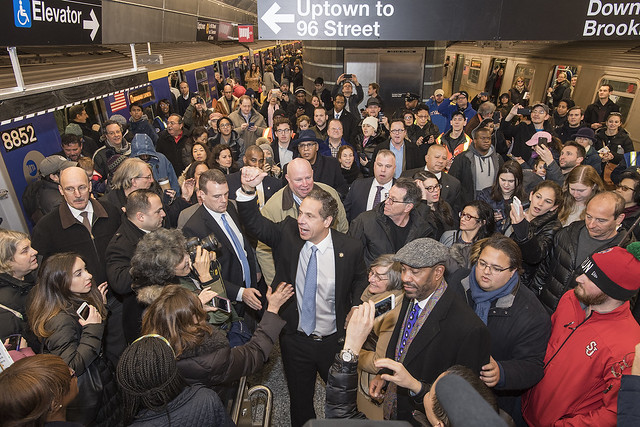
(photo: MTA/Patrick Cashin)
We call it the distraction circus. Donald Trump’s advisor, Steve Bannon, called it “flooding the zone with sh*t” to befuddle the news media and critics. Whatever you call it, the endless kerfuffle Governor Cuomo is stirring around the Metropolitan Transportation Authority (MTA) is obscuring what we think are the MTA’s potentially catastrophic money problems.
Yes, even after new revenue from congestion pricing is factored in, the MTA is still in big financial trouble.
Five very big things jump out in terms of the MTA’s fiscal health. First, Governor Cuomo and legislative leaders are sending strong signals they are going to renege on the remaining $7.3 billion they promised the MTA in direct state aid in the 2016 state budget for the 2015-2019 MTA capital plan. Second, the governor says state monies will generate only about $30 billion of the $40 billion to $60 billion his own workgroup estimated the MTA needs for its 2020-2024 capital plan.
Third, the governor is strongly suggesting the MTA will have to borrow roughly $10 billion to $30 billion on top of its already soaring debt load. Fourth, even with massive cost cutting, the MTA’s debt payments are rising to alarming levels, with 19% of operating income possibly going to debt by 2022, raising the harbinger of a “death spiral.”
Fifth, these are not the MTA issues the Board, Legislature, or transit reporters are talking about nearly enough.
Importantly, the MTA is facing these dire fiscal pressures while New York City’s economy is in the midst of a decade-long boom and state and city tax revenues are at record levels. What happens when there is the inevitable downturn?
The MTA is Fiscally Exhausted, so Where is the $7.3B?
With much fanfare, the Governor and State Legislature included in the 2016 state budget a “historic” commitment of $8.3 billion in direct state aid to the MTA’s 2015-2019 capital plan. More than three years later, the state still owes the MTA $7.3 billion.
The devil is truly in the details for state budget promises. The much touted 2016 state bailout of the MTA allowed $1 billion to be given to the MTA without condition, but an additional $7.3 billion will only be available after the MTA borrows until it can borrow no more -- in other words, when the MTA is fiscally “exhausted.” (See Part NN of the 2016 budget.)
As of May 2019, the MTA has gotten only $1 billion of the state bailout money promised in 2016, and $11 billion from all sources for the $33 billion it planned to spend on the 2015-2019 capital plan.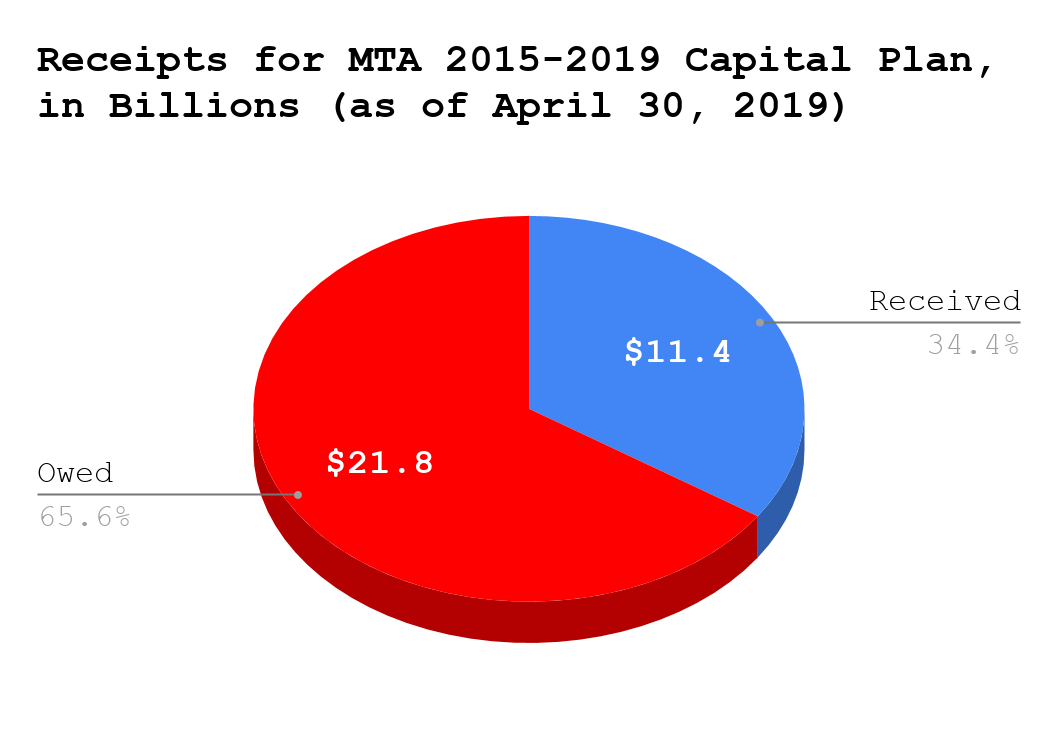
The Subway Action Plan: A Distraction from the $7.3B owed by the State?
As of December 2017, the MTA had received only $65 million of the state capital dollars promised in the April 2016 state budget for its 2015-2019 capital plan. In July 2017, the governor announced the Subway Action Plan, which included $328 million for capital projects (which is less than 5% of the $7.3 billion of the promised state capital funds). Yet, the Subway Action Plan has become a proxy for effort by the state. The governor’s office has repeatedly emphasized the millions the state was contributing to the Subway Action Plan while glossing over the $7.3 billion it owes the MTA.
[READ: There's Plenty of Money in the MTA Capital Plan, It's Just Not Being Spent]
MTA Tens of Billions Short of Funding Needed for Capital Plan Starting in 2020
To recap, the state still owes the MTA $7.3 billion for the current, 2015-2019 capital plan. Now, the governor says the MTA won’t get new state funding for the next capital plan.
Last week, Governor Cuomo doubled down on his rhetoric that the MTA must “reform” or it won’t get more funding from the state for the MTA’s 2020-2024 capital plan. Speaking on The Brian Lehrer Show, the governor said that the MTA will get only $30 billion from the state for the MTA 2020-2024 capital plan, including congestion pricing and state dedicated taxes, saying it needs to do better with the billions it has. This is much less than the $40 billion to $60 billion Cuomo’s own MTA Sustainability Workgroup concluded in December 2018 would be needed for the 2020-2024 plan.
The biggest problem with this statement is that the MTA is already fiscally exhausted, and “reform” -- including possible consolidations from a forthcoming reorganization plan (more on that here) -- will not possibly make up the additional $10 to $30 billion that the MTA is missing to meet its needs for the next capital plan.
Skyrocketing Debt Payments: 19 Cents of Every Fare Dollar
While the MTA has been borrowing itself into a state of “fiscal exhaustion” to meet the terms of the 2016 state budget for its promised $7.3B, debt service payments have soared to record levels.
In 2017, debt payments cost 17% of the MTA’s operating budget. By 2o22, debt payments will consume 19% of the operating budget, as projected in its February 2019 financial plan. (All charts in this piece are sourced from data in this plan.)
In total, debt payments will be $3.22 billion in 2022 -- an increase of 27% since 2017.

And with a threat from the governor of no more state funding, the MTA seems to be on the path toward even more borrowing if it is to even attempt to meet its capital needs for 2020-2024.
Blunt Cuts Won’t Save the MTA
With debt service on the rise and ridership declining, the MTA is facing a large operating deficit. The operating budget pays for everyday subway, bus, and rail service, and money borrowed to pay for capital expenses. Every dollar paying back borrowed money is a dollar that cannot be spent on subway or bus service.
As debt costs soar, so does the ongoing gap between the MTA’s income and expenses. The MTA’s deficit for 2020 has now reached $467 million, with even larger gaps in the years to come. (To be sure, the MTA is also struggling with costs including health care for current and retired workers -- a problem for many big employers in the U.S.)
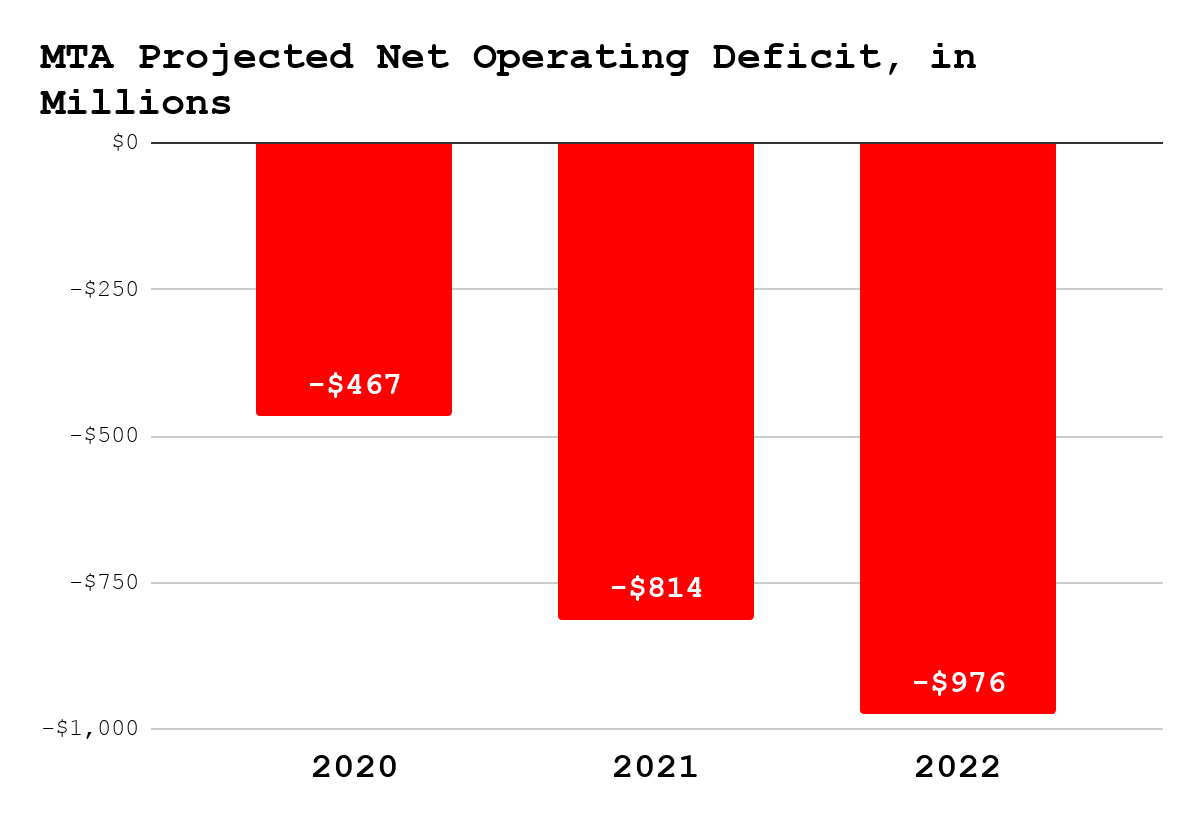
If the MTA can’t reduce its debt payments, how can it make up future operating losses? The biggest likelihood is through workforce reductions, which could increase the risk of entering a “death spiral” of less service, fewer riders, and less farebox revenue. Labor makes up 60% of operating costs and the MTA’s labor contracts are up for renewal this year. The MTA has 75,000 employees and is by far the largest unit of state government.
There are rumors of big layoffs circulating within the MTA. The obvious concern for riders is how layoffs affect customer service. A smart reorganization of the MTA could make sensible consolidations, but there is tremendous pressure to close the MTA’s operating deficit and chop out dead wood. The risk is the reorganization could decimate the MTA’s workforce at a time when working for the MTA is not likely at the top of job seekers’ lists, all while the governor continues to harshly criticize the MTA professional staff for lack of innovation and execution.
Exhausted and in Danger
In the 2016 budget, the governor and Legislature committed $8.3 billion to the MTA. They have given it $1 billion. Will the MTA get the remaining $7.3 billion? Will the governor and Legislative Leaders finally level with the public? Where the heck is the MTA supposed to find the roughly $50 billion it needs for the 2020-2024 rebuilding plan? How much money does the MTA really need? What is the debt redline? Some states keep debt payments at 5% to 7% of their operating budgets, while the MTA is edging towards an astronomical 19%. The danger signs for the MTA are mounting, and we need an honest discussion of how to fix this problem before it’s too late.
[READ: There's Plenty of Money in the MTA Capital Plan, It's Just Not Being Spent]
***
Rachael Fauss is Senior Research Analyst and John Kaehny is Executive Director at Reinvent Albany. On Twitter @ReinventAlbany.
***
Have an op-ed idea or submission for Gotham Gazette? Email This email address is being protected from spambots. You need JavaScript enabled to view it.
As HRA Announces Closure of Another Food Stamp Center, Research Finds Excessive Wait-Times
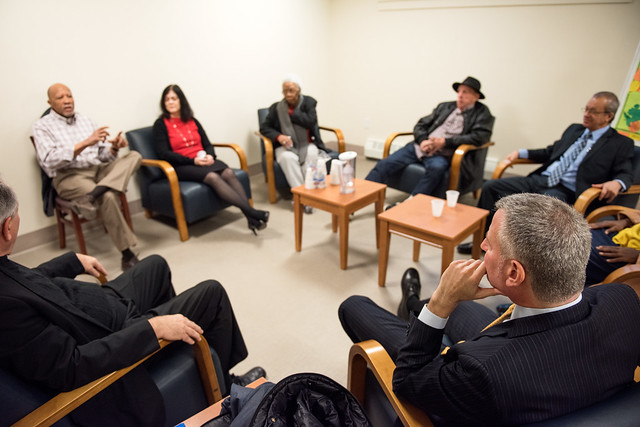
(photo: Demetrius Freeman/Mayoral Photography Office)
During a recent budget hearing at the City Council, Council Member Stephen Levin asked Social Services Commissioner Steven Banks about wait-times at Human Resources Administration centers. "Have we seen an increase in wait times?” asked Levin; “How are we monitoring wait-times in light of the Jazmine Headley incident and as we're talking about staffing levels at HRA Centers?”
Confident in tone and content, Commissioner Banks answered: "[I]n SNAP and food stamp centers the wait-time is about 20 minutes because 87% of the applications are done online and 93% of the interviews are done by phone, and there's a reduction of foot traffic by more than 40% in those locations.” He continued, “and in terms of the wait-times in the Job Centers...we're about twice as long in those offices as in the food stamp centers."
Our team has conducted a significant analysis of the underlying data the city uses to calculate and report its wait times. We believe that Commissioner Banks’ response is misleading.
The use of misleading data on this matter is a risk for all poor New York City residents, and takes particular importance given the closure of two SNAP (food stamp) centers last year, and the recently-announced closure of the St. Nicholas SNAP Center in Harlem, which is planned for the end of this month.
A Background to Waiting at HRA
Council Member Levin’s May 22 questions above were referring to an incident in December 2018, captured on a cell phone video that went viral, when police assaulted Jazmine Headley and her infant son at a Brooklyn Public Assistance center. Headley had already waited in the center (otherwise known as a Job Center) for four hours before the situation unnecessarily escalated to police violence.
While the media justifiably focused on the physical violence she experienced, Headley’s story also raised another, less-publicized issue that our clients at Urban Justice Center report to us daily: excessive wait-times at HRA that cause upset children, missed days of work or school, increased tension at centers, and unnecessary interruptions in their lives.
New York City’s welfare and food stamp (SNAP) centers are notorious for using wait-times to prevent or delay benefits access. Under Mayor Koch in the 1980s, the city’s efforts to prevent benefits access were so significant that Community Action Legal Services issued a report entitled The In-Human Resources Administration’s Churning Campaign. Under Mayor Giuliani in the 1990s, those in need of food stamps could not even obtain an application until their second center visit. Under the Bloomberg administration, public assistance recipients continued to be systematically discouraged from accessing cash aid by HRA.
Mayor de Blasio’s administration is undoubtedly more receptive of benefits applicants than those that preceded it; however, our analysis of the city’s wait-time data shows that the client experience at HRA is still unreasonable and unacceptable.
In February of this year, in the wake of the violence experienced by Headley, the City Council held a hearing about the experiences of people at HRA centers. When Council members asked HRA officials why Headley’s attempt to complete a seemingly simple task had taken four hours at one of their centers, they explained that her situation that day was an exception. However, the findings we published in our recent Bureaucracy of Benefits report, based on surveys of over 130 HRA applicants and recipients, found that wait times averaged 3.13 hours at Public Assistance (Job) Centers and 2.78 hours at SNAP centers.
Under a local law passed at the end of 2017, HRA must post the “average” wait times at centers on its website. In January 2019, the reported citywide wait time averages were 50 minutes for Job Centers and 45 minutes for SNAP centers. These are the numbers HRA administrators seemingly refer to when publicly questioned about the centers’ wait times, and presumably provided the rationale for calling Headley’s four hour-long wait an “exception.”
In an effort to determine why the city’s publicized wait times are significantly less than what our surveys reflected and what we hear so often from people who go to the centers, we issued a Freedom of Information (FOIL) request for the breakdown of the center wait-times.
What We Found
Our review found that HRA manipulates the data to make it appear as though people are waiting significantly less time in centers and then putting forward numbers publicly that do not match the reality poor New Yorkers experience each day.
The picture painted by city officials in testimony and in the online data is that visits to HRA Centers are fairly simple and quick experiences. But they are not. Furthermore, there are patterns in the data that show disproportionately heavy delays in the Bronx – the poorest borough and where the city has the highest rates of complaints at Job and SNAP Centers (see Bureaucracy of Benefits report).
The data shows that HRA, which is the nation’s largest social service agency and which claims its role is the “effective and efficient administration of more than 12 major public benefits programs, which reflects this Administration's priority of addressing poverty and income inequality,” routinely makes New Yorkers wait several hours at its offices for any and all needs. Our analysis confirms that Headley’s experience with waiting was far more common than officials admitted and resonated closely with what our clients tell us everyday.
1. Ticket-stacking: HRA’s data is compiled by tracking the amount of time that it takes for an individual to be called for a “ticket,” which individuals are given when they go into a center (for the purpose of our analysis, “ticket” refers to the tracking system HRA uses to delineate the reasons for a person’s visit to the center). However, when an individual goes to the center, they frequently need more than one ticket to accomplish a particular task. Sometimes they get multiple tickets upon entering, and sometimes they will be given additional tickets successively, either because the first person they met with was not able to help them or because there are multiple steps to a particular task.
For example, in order to apply for a new Public Assistance case, an individual must fill out a lengthy application and then also complete an application interview. These are each individual tickets. HRA is averaging the data as if each of these is a singular experience for which an individual might visit a center, when in reality, applicants are doing both in one trip. The citywide average wait time in September 2018 for an application was 17 minutes, but the average wait time for an interview was 1 hour and 34 minutes. HRA is averaging these two numbers together in calculating overall wait-time averages, when in fact they should be combined to get a complete picture of the applicant’s wait time.
2. Unweighted data: HRA’s data seemingly does not account for ticket volume by center. For instance, in September 2018, HRA calculates the citywide average wait time for those presenting to resolve a Cash Assistance (CA) missed appointment at 45 minutes. When we calculated the data weighting the amount of time against the amount of tickets for missed CA appointments, we calculated an average wait time of 1 hour and 37 minutes, more than doubling the city’s reported figure.
3. Averaging-in zeros: According to the data, not all centers give out every ticket type in any given month. It is unclear if this is because each center employs its own practices of assigning tickets, or if some centers simply do not see certain needs in a given month. Regardless, the fact that HRA includes the tickets without any data (and therefore zero-minute wait-times) in their overall averaging provides a highly skewed presentation of what is actually happening. For instance, HRA reported (in response to our FOIL request) that the citywide average wait time to see a supervisor was 30 minutes in September. However, five centers did not report any tickets given for waiting to see a supervisor. HRA is including zero-minute waits from these five centers, which skews the citywide average.
4. Exceptional waits for Bronx residents: Repeatedly, Bronx Centers had the highest wait times reported. In September 2018, the Citywide Average Wait time for a supervisor was 30 minutes. However, at Concourse Center in the Bronx, wait-time to speak with a supervisor was 1 hour and 16 minutes. Bronx Centers had the highest (or second highest) wait times for almost every issue area we reviewed, including childcare, cash assistance application interviews, cash assistance recertifications, cash assistance reopenings, cash assistance missed appointments, and cash assistance mandatory dispute resolutions, among other appointment types.
5. Excluding service times: The publicly posted wait-time data fails to capture the additional time that individuals spend in the Center actually completing the services they came for, or the “service-time data,” which can be hours.
For the application interview, the citywide service time average in September 2018 was 47 minutes. Combined with the average service time for the application itself (5 minutes) and the wait times for both the application and application interview, an individual who needed to apply for Public Assistance in September 2018 was spending, on average, over 2.5 hours at the center. If they requested to speak to a supervisor for any reason, the overall time would go up to over 3 hours and 20 minutes. In cases where someone is waiting for multiple appointments in one visit, it is likely they will spend the majority of their day at the Center.
The extensive wait-times for benefits is yet another example of how New York City punishes people for poverty. Available data shows that people of color are disproportionately forced to rely on benefits to survive, and that women are disproportionately the “heads of household” for a family’s benefits case. To make matters worse, almost none of the mandatory services for Public Assistance applicants or recipients can be done online or over the phone. That means that in order to receive Public Assistance benefits, one must be prepared to wait – for hours and repeatedly.
While Commissioner Banks says improvements are coming through technology – and we have already seen some of the city’s technological developments unfold for SNAP-only cases – we remain very concerned that there is a significant need for increasing staff at the centers rather than simply focusing on robotic solutions.
And we are very concerned about HRA’s closure of a third SNAP Center this coming month. Of note, that closure will push SNAP recipients assigned to the St. Nicholas Center in Central Harlem to the East End Center in East Harlem, which is already known by advocates to struggle with caseload requirements that lead to long waits and often very serious case errors.
The waiting imposed on poor New Yorkers is long-standing and punitive but is it not inevitable. Increasing staff at HRA centers, increasing the number of benefits centers in each borough, and making it easier for New Yorkers to resolve problems and complete needed actions over the phone and online would all help significantly. Halting the closure of SNAP centers is another immediate step that can be taken to prevent excessive waits and pervasive errors in people’s cases.
Different decisions about allocating resources can be made that would reduce the notoriously frustrating length of time poor people spend waiting for and interacting with the city’s benefits bureaucracy. The question is whether our city is willing to do so.
***
by Kiana Davis, Isabel Hellman, Craig Hughes, Khadija Hussain & Helen Strom of the Urban Justice Center – Safety Net Project. On Twitter @SafetyNetUJC.
***
Have an op-ed idea or submission for Gotham Gazette? Email This email address is being protected from spambots. You need JavaScript enabled to view it.
When Owners Neglect Buildings and Don’t Pay Taxes, Tenants Suffer – The City Can Help

(photo: Edwin J. Torres/Mayoral Photography Office)
As Benjamin Franklin famously wrote, "in this world, nothing can be said to be certain, except death and taxes." This is true for property owners who maintain their buildings and pay their property taxes in full each year, but for the few who do not, there can be consequences, including foreclosure.
Often, the failure to pay taxes is indicative of a litany of issues, such as physical deterioration of the building. Imagine being a resident of a tax-delinquent building: you've worked hard to pay your rent, and you learn that your landlord hasn't paid their taxes, and now, on top of caring for your family, you’re terrified of losing your home, uprooting your kids' lives. Or you are a renter in a struggling co-op who sees your rent go up dramatically even while conditions in the building worsen. What if you can’t find another affordable place to live? Do you have to leave New York City? How is it fair that you've played by the rules and now have to bear the brunt of your building owner’s actions?
Decades ago, the City launched the Third Party Transfer (TPT) program, which is one of the ways that we hold building owners accountable while protecting residents by transferring tax-delinquent properties to an affordable housing developer to keep people in their homes with robust rent stabilization and other affordability protections. And it works: since 1996, we've provided stability and improved living conditions for nearly 15,000 New Yorkers.
The de Blasio Administration has spent five years marshaling resources to build and preserve affordable housing across the city, and increase enforcement and other protections to keep residents in their homes. We believe that anyone who wants to raise a family and work in the city should be able to live here.
I want to be very clear because there has been rampant speculation and misinformation about the Third Party Transfer program. Ownership creates stability for families and neighborhoods, and the opportunity to build equity that can be passed along to future generations. Our primary goal is to assist struggling owners with repairs and unpaid taxes and violations, which is why we do significant outreach over several years and offer numerous resources to help. More than 80% of the 420 properties included in the last round of Third Party Transfer successfully addressed their municipal arrears and were removed from the foreclosure action.
As an administration, we can look the other way and allow buildings to fall further into debt and eventually disrepair or we can proactively work with owners to keep their hard-earned slice of the city. So we’re going to do more to find new ways to address how the city's housing landscape has changed over the past 20 years. Working with City Council Member Robert Cornegy, the chair of the Council's Housing and Buildings Committee, and other stakeholders, we are launching a new working group to recommend changes to address concerns and make the program better.
The City is committed to making the process as transparent and effective as possible and helping homeowners avoid the spiral of financial and physical deterioration that puts properties at risk in the first place. But as New Yorkers face ever-rising rents and become more vulnerable to displacement, ending the program outright would be a disservice to tenants left to suffer the consequences when building owners can't or won’t address their financial issues.
***
Louise Carroll is the Commissioner of the New York City Department of Housing Preservation and Development. On Twitter @NYCHousing.
***
Have an op-ed idea or submission for Gotham Gazette? Email This email address is being protected from spambots. You need JavaScript enabled to view it.
For Bail Reform to Work Invest in Communities, Not Prosecutors
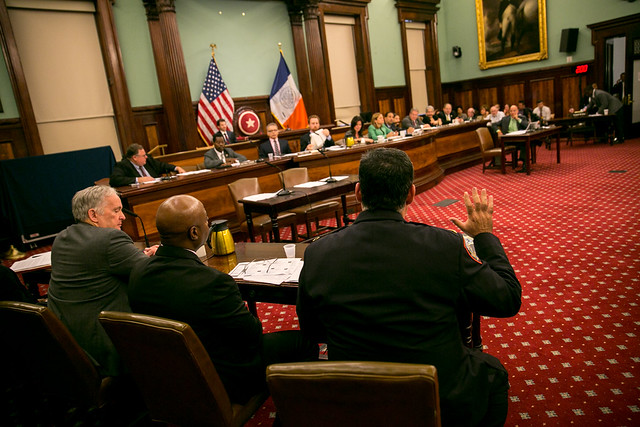
(photo: William Alatriste/City Council)
We are in a unique moment in history. New York City is embroiled in a process to build new jails -- the aftershock of a grassroots campaign to shut down the human rights catastrophe at Rikers Island. New York State recently passed bail reform, which must be implemented in every county on or before January 1, 2020, and across the country “criminal justice reform” and “ending mass incarceration” have become mainstream conversations -- an unthinkable reality just ten years ago. It’s a moment that carries monumental opportunities and tremendous risks.
For New York City to make the most of this movement, we must reconsider how we think about criminal justice reform and reset the dial towards progress and equity outside the system.
Actions and planning cannot be narrowly focused; instead our elected officials must be prepared to fight for the fundamental needs of the communities from which city jails draw their populations. This must include massive investments -- billions of dollars -- to fund what communities have long been starved for: healthcare, housing, education, and other fundamental resources.
Recently in Manhattan, the Mayor’s Office of Criminal Justice presented at the last of four community board hearings on the city’s new jails plan. Just after, the City Council held its first hearing on the implementation of statewide reforms to bail and discovery rules. Just before, Council Speaker Corey Johnson unveiled his own plans for criminal justice reform in New York City.
Each of these presentations were standard: they focused on prosecutors, public defenders, courts, police, infrastructure, land use, and “off-ramps” for people already caught up in the system. This is typical criminal justice reform rhetoric. But they also mirror “reforms” across the country which have (unwittingly or not) ended up expanding the reach of the carceral system rather than shrinking it.
New York State has reached a tipping point, and could serve as a model for the rest of the country by calling for a dramatic expansion in the scope of what would be required to truly take on “mass incarceration.” We must get away from the old-fashioned notion that crime is a result of moral or personal failures that can be cured one case at at time, instead of a socio-political problem dictated by structural inequality, poverty, race and politics. We must acknowledge and act on the reality that criminal justice reform will never be successful or sustainable when it is siloed off from other crucial social issues that impact our society’s most marginalized.
Jails have long served as the catchall way to manage New York City’s most pressing crises: record homelessness, unmet mental and behavioral health needs, substance use disorders (SUD), joblessness, and poverty. (The same is true across the country.)
In general jail populations are symptoms of failed social policies and the politics of mass incarceration. According to reports, 16% of the daily jail population in New York is people who have been diagnosed with a serious mental illness, and 75% have a substance use disorder. These numbers are similar to incarcerated populations across the country.
New jails cannot address record high homelessness, record high overdose deaths (which remains the leading cause of death in New York City shelters), joblessness, and poverty. Nor can they address the shameful history of racial discrimination and divestment from our communities. Bail reform—which should reduce the jail population—can’t address these issues either if implementation focuses solely on city government’s new legal responsibilities under the law.
At the most recent hearing on the city’s response to statewide reforms, City Council members and the Mayor’s Office of Criminal Justice (MOC-J) both listed as their partners in implementation the local district attorneys, the office of court administration, public defenders, and the police department. Implementation would only be successful, testimony suggested, if millions of dollars were poured into prosecutor offices. But there was no mention of Health + Hospitals, the Department of Health and Mental Hygiene, or the Department of Social Services in this conversation. No one raised the fact that jails operate as one of the city’s largest homeless shelters, and neither the Department of Homeless Services or the Department of Housing Preservation and Development were invited.
The city risks missing the point here. Omitting the fundamental needs of the community means more overdose deaths, homelessness, joblessness, and poverty. It ultimately means, more incarceration and criminalization. As the jail population drops, what resources are we giving directly to communities in order to keep them safe, thriving, and able to manage inevitable conflicts and tensions without relying on a criminal punishment system that has historically failed to resolve any social problem? Why isn’t Steve Banks -- the Department of Social Services commissioner -- leading this work, instead of a thin MOCJ task force?
The city is preparing to spend $8.7 billion to construct four new jails over the next several years as part of a plan to close the Rikers Island complex. That plan does not include ANY investment into marginalized communities impacted by incarceration -- despite research that these investments can credibly decrease incarceration, which is, after all, the city’s stated goal. The City Council’s first stab at bail reform implementation also appears headed towards massive investments into the system, while ignoring community investments.
New York City has a tremendous opportunity to reinvest in communities to help them thrive and to make them safer. To get there, we must expand the scope of this discussion and address the root causes of the social problems that we have tried and failed to address through mass incarceration, policing, and criminalization while stigmatizing generations of our fellow New Yorkers.
***
Nick Encalada-Malinowski is the Civil Rights Campaign Director at VOCAL-NY. On Twitter @nwmalinowski.
***
Have an op-ed idea or submission for Gotham Gazette? Email This email address is being protected from spambots. You need JavaScript enabled to view it.




